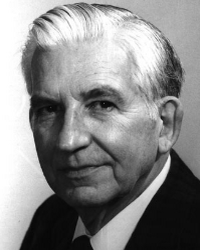 |
|
Prof. Joseph E. Burke was born in Berkeley, California, USA. He lived his early years in Canada and was a 1938 graduate of McMaster University. He received his doctorate in ceramic science from Cornell University and worked for the International Nickel Company and the Norton Company until being handpicked in 1943 to join the world-famous Oppenheimer-led Manhattan Project team at Los Alamos, New Mexico, National Laboratory. He helped design, build, and manage the first large-scale facility for the preparation of plutonium nitrate and its conversion to bomb cores. Dr. Burke’s contributions to the development of the first atomic weapon were eventually detailed in “Recollections of Wartime Los Alamos: Uranium Hydride Preparation and Plutonium Processing” (Journal of Nuclear Materials, Volume 100, November 16, 1981). After the war, Dr. Burke became a faculty member at the Institute for the Study of Metals at the University of Chicago, where he worked on the origins of microstructure in metals and the kinetics of grain growth. In 1949 he joined the Knolls Atomic Power Laboratory (KAPL), first as a research associate, later as manager of metallurgy.
From 1972 to 1979, Dr. Burke had assignments in program planning and other special activities at the GE R&D Centre. Later he resigned to become a consultant in materials science and engineering. He also served as an adjunct professor of ceramics at Rensselaer Polytechnic Institute in Troy, New York. The result of this long and intensive laboratory effort—Lucalox—was licensed and sold for many uses by General Electric but soon became of special interest to GE’s Lamp Division, where Lucalox lamps have had a very extensive impact on the world’s lighting business—and Bottom of Form the conservation of energy.
Dr. Burke was elected to the National Academy of Engineering in 1976. He had been active in the American Ceramic Society (ACS), of which he was a fellow, for many years, and was made a distinguished lecturer in 1972, president in 1974, and a distinguished life member from 1982. From the ACS, he received the John Jeppson Medal in 1981 and the W. David Kingery Award in 1999. He also was a fellow of the American Nuclear Society and the American Society for Metals (ASM) and a member of the British Ceramic Society and the American Association for the Advancement of Science. He also was a fellow of the American Nuclear Society and ASM International. Results of his work are documented in six patents and more than 40 technical papers. He was co-author, with A. U. Seybolt, of the book Procedures in Experimental Metallurgy (Wiley, 1953) and co-editor, with D. W. White, of The Metal Beryllium (American Society of Metals, 1955). He also served as editor of a review series, “Progress in Ceramic Science.”
Joseph E. Burke, a key innovator in the “science of ceramic materials” died in Schenectady, New York, on February 29, 2000.
Taken from The National Academic Press, Volume 14 (2011)
